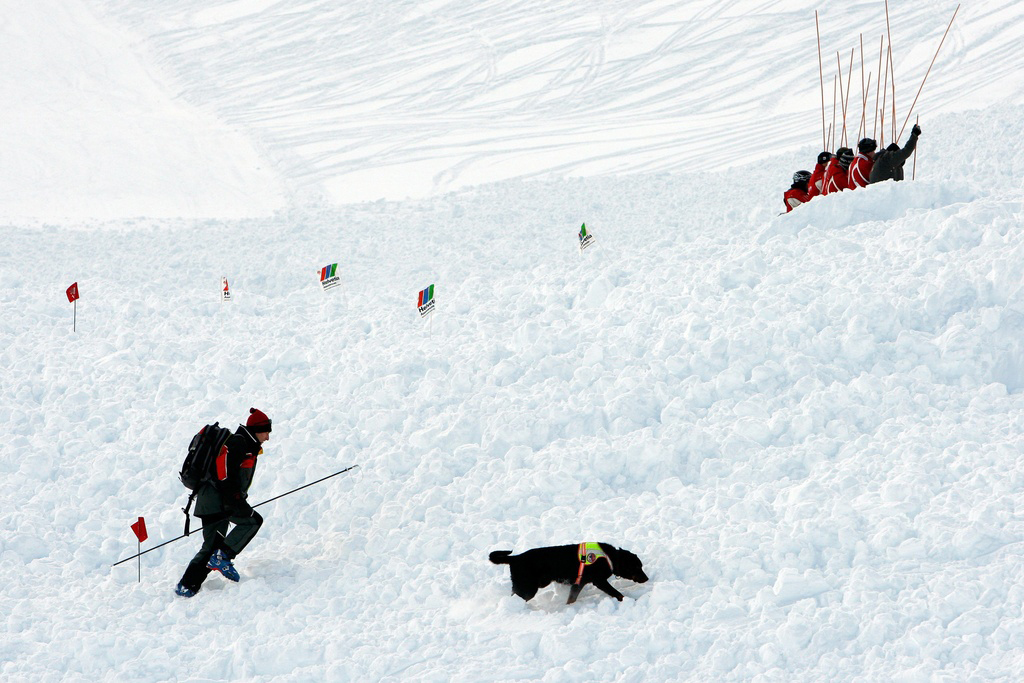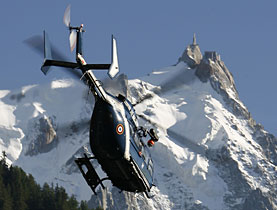Off-pisters face fines for causing avalanches

Avalanches onto marked ski runs in canton Valais, triggered by off-piste skiers, have provoked a debate about liability and sanctions for those who flout warnings.
Six people have been reported to the cantonal prosecutor for allegedly setting off avalanches that swept onto pistes in Anzère and Zermatt where people were skiing, the Valais police reported on Monday.
“It’s about sending a message that skiers who don’t respect others can be prosecuted,” police spokesman Jean-Marie Bornet told Associated Press.
Tragedy was narrowly avoided in Anzère, near Crans-Montana, on December 27 when three off-piste skiers triggered a 200-metre-wide avalanche that crossed a marked piste, injuring two people. In total, 130 people were involved in the rescue operation.
A 34-year-old woman and two men, aged 42 and 32, were questioned by police and reported to the judicial authorities.
In a similar incident on December 31, a group of seven people skiing off-piste in Zermatt reportedly set off an avalanche in the Grünsee region that ended on a marked run. A 14-year-old girl from the group was slightly injured.
Three adults from the group – a 51-year-old man from Geneva, a 44-year-old French woman and a 19-year-old boy – were also reported to the prosecutor.
Heavy snow in recent days has prompted officials to warn of a heightened avalanche risk in the Swiss Alps. Every year around 130 avalanches are caused by skiers and snowboarders in Switzerland, which result in an average of 25 deaths.
On Sunday seven people died and five were injured in the Bernese Alps when a first avalanche hit a group of ski mountaineers and a second buried rescue workers and skiers assisting in the operation to free them. It is the most serious avalanche accident in Switzerland since February 1999.
Reckless acts
Heinz Walter Mathys, a lawyer and president of the Swiss commission for the prevention of snow sports accidents, said anyone found to have caused an avalanche through irresponsible skiing could, and should, face some form of civil or criminal proceedings.
“People need to know that under Swiss law anyone leaving the marked runs who causes an avalanche like this can be charged under article 237 of the Penal Code for interference with public circulation,” he told swissinfo.ch.
In Switzerland off-piste skiing is not illegal. Ski runs and off-piste zones are both part of the public domain. But reckless acts like ignoring avalanche warning signs and then setting off an avalanche that hits a marked run can lead to a conviction, even if there are no victims.
“The fact of creating a danger is enough, and the justice system is now much more sensitive than in the past,” said Valais lawyer Pierre-André Veuthey.
Freeriders responsible for similar incidents to those in Anzère and Zermatt have been given fines of SFr1,000 ($970) and asked to pay for damages and to meet the cost of the rescue operation – often tens of thousands of Swiss francs. Irresponsible skiers have also had their ski passes taken away and been put on resort blacklists.
Law enforcement
Mathys felt Swiss law was adequate for dealing with people who flout warnings and put others at risk. But the problem, he said, was one of enforcement and being able to catch those at fault.
“It’s a political question. Do we want state police with sanction powers or not?” he asked. “I am personally against police on the slopes. It’s possible to act against those who endanger lives under Swiss civil, penal and administrative law.”
But Franz Werro, professor of private law at Fribourg University, was of a different opinion.
“It’s a cultural thing,” he told World Radio Switzerland. “Swiss people would be shocked to see police on the slopes, but maybe we need to get there.”
Switzerland, like France, Spain, Austria and Germany, rejects the preventive presence of police on the slopes. The European exceptions are Italy and Slovenia, where officers on and off the slopes can verbally sanction or fine wild boarders and skiers for endangering others.
But ultimately you can’t stop people from going off-piste, Guido Guidetti, head of mountain safety at Villars, told 24 Heures newspaper.
“You can close a run by putting up barriers but someone will always slip through. The only weapon available to resorts is prevention.”
Yves Jacquier, director of the Télé Anzère lift company, agreed prevention was the solution but said it was not easy.
“We can only inform people and dissuade them when it’s dangerous, but our means are limited compared with the ski manufacturers who use the snow to sell people ideas like freedom,” he added.
Simon Bradley, swissinfo.ch
The Swiss Institute for Snow and Avalanche Research (SLF) last week released the findings of a study which said better gear and improved awareness had led to a drastic reduction in the number of people killed each year by avalanches.
According to the institute, around 40 per cent of people caught in avalanches die. At the end of the 1970s, the figure was around 60 per cent.
The authors of the study said off-piste skiers, snowboarders and snowshoers are better equipped nowadays, are more likely to inform themselves about local snow conditions and know how to react to free colleagues trapped in an avalanche.
Between 1977 and 2006 nearly 3,500 people were caught in slides in the Swiss Alps. More than 700 died. While 27 people on average were killed each winter over the first 15 years, only 20 died per year in the second half of this period.
The SLF recommends that people going off-piste be equipped with emergency gear such as shovels and transceivers. Equally important is knowing how to use them, it said.
1 low – avalanche possible only with high additional loads (e.g. groups of skiers without spacing, snowmobile), on very few extreme slopes. Only natural sluffs (small loose snow avalanches) and small avalanches possible.
2 moderate – triggering possible especially through high additional loads, mainly on steep slopes indicated in bulletin. Large natural avalanches not expected.
3 considerable – triggering possible even through low additional loads, mainly on steep slopes… In certain conditions, some medium and occasionally large natural avalanches possible.
4 high – triggering is probable even through low additional loads on many steep slopes. In certain conditions, many medium and multiple large natural avalanches are expected.
5 very high – many large natural avalanches are expected even in moderately steep terrain.
(Source: Swiss Federal Institute for Snow and Avalanche Research)

In compliance with the JTI standards
More: SWI swissinfo.ch certified by the Journalism Trust Initiative














You can find an overview of ongoing debates with our journalists here . Please join us!
If you want to start a conversation about a topic raised in this article or want to report factual errors, email us at english@swissinfo.ch.